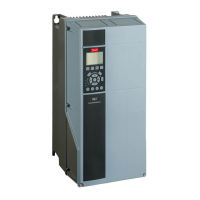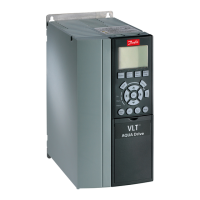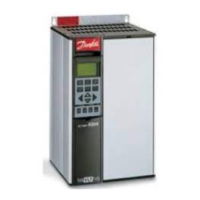1-73 Flying Start
Option: Function:
This function enables catching a motor which is
spinning freely due to a mains drop-out.
When parameter 1-73 Flying Start is enabled,
parameter 1-71 Start Delay has no function.
Search direction for
ying start is linked to the
setting in parameter 4-10 Motor Speed Direction.
[0] Clockwise: Flying start searches in clockwise
direction. If not successful, a DC brake is activated.
[2] Both Directions: The ying start rst makes a
search in the direction determined by the last
reference (direction). If the speed is not found, it
makes a search in the other direction. If not
successful, a DC brake is activated in the time set
in parameter 2-02 DC Braking Time. Start then
takes place from 0 Hz.
[0] Disabled
Select [0] Disable if this function is not required.
[1] Enabled
Select [1] Enable to enable the frequency
converter to catch and control a spinning motor.
The parameter is always set to [1] Enable when
parameter 1-10 Motor Construction=[1] PM non-
salient.
Important related parameters:
•
Parameter 1-58 Flying Start Test Pulses
Current
•
Parameter 1-59 Flying Start Test Pulses
Frequency
•
Parameter 1-70 PM Start Mode
•
Parameter 2-06 Parking Current
•
Parameter 2-07 Parking Time
•
Parameter 2-03 DC Brake Cut In Speed
[RPM]
•
Parameter 2-04 DC Brake Cut In Speed [Hz]
•
Parameter 2-06 Parking Current
•
Parameter 2-07 Parking Time
[2] Enabled
Always
[3] Enabled
Ref. Dir.
[4] Enab.
Always
Ref. Dir.
The ying-start function used for PM motors is based on
an initial speed estimation. The speed is always estimated
as the rst thing after an active start signal is given. Based
on the setting of parameter 1-70 PM Start Mode the
following happens:
Parameter 1-70 PM Start Mode=[0] Rotor Detection:
If the speed estimate appears as greater than 0 Hz, the
frequency converter catches the motor at that speed and
resumes normal operation. Otherwise, the frequency
converter estimates the rotor position and start normal
operation from there.
Parameter 1-70 PM Start Mode=[1] Parking:
A speed estimate lower than the setting in
parameter 1-59 Flying Start Test Pulses Frequency engages
the parking function (see parameter 2-06 Parking Current
and parameter 2-07 Parking Time). Otherwise, the frequency
converter catches the motor at that speed and resumes
normal operation. Refer to the description of
parameter 1-70 PM Start Mode for recommended settings.
Current limitations of the
ying-start principle used for PM
motors:
•
The speed range is up to 100% nominal speed or
the eld weakening speed (whichever is lowest).
•
PMSM with high back EMF (>300 VLL(rms)) and
high winding inductance (>10 mH) needs more
time for reducing short-circuit current to 0 and
may be susceptible to error in estimation.
•
Current testing limited to a speed range up to
300 Hz. For certain units, the limit is 250 Hz; all
200–240 V units up to and including 2.2 kW and
all 380–480 V units up to and including 4 kW.
•
For high-inertia applications (that is, where the
load inertia is more than 30 times larger than the
motor inertia), use a brake resistor to avoid
overvoltage trip during high-speed engagement
of the ying-start function.
1-77 Compressor Start Max Speed [RPM]
Range: Function:
Size
related*
[ 0 -
par.
4-13
RPM]
NOTICE
Parameter 1-77 Compressor Start Max
Speed [RPM] has no eect when
parameter 1-10 Motor Construction=[1]
PM, non-salient SPM.
The parameter enables high starting torque.
This is a function, where the current limit and
torque limit are ignored during start of the
motor. The time, from the start signal is given
until the speed exceeds the speed set in this
parameter, becomes a “start-zone” where the
current limit and motoric torque limit is set to
what is maximum possible for the frequency
converter/motor combination. This parameter
is normally set to the same value as
parameter 4-11 Motor Speed Low Limit [RPM].
When set to zero the function is inactive.
In this starting-zone, parameter 3-82 Starting
Ramp Up Time is active instead of
parameter 3-40 Ramp 1 Type to ensure extra
acceleration during the start and to minimise
Parameter Descriptions
VLT
®
HVAC Drive FC 102
48 Danfoss A/S © 03/2015 All rights reserved. MG11CE02
33

